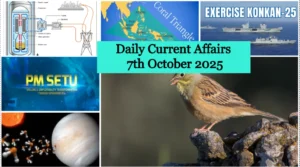Daily Current Affairs-17th September 2025
Daily Current Affairs-17th September 2025
Nankana Sahib
Political parties and Sikh bodies recently urged the Centre to reconsider its decision asking State governments not to process applications for pilgrimage to Nankana Sahib in Pakistan on the occasion of the birth anniversary of Guru Nanak Dev.
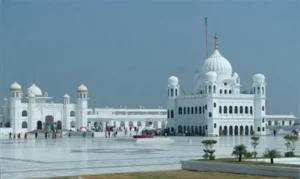
About Nankana Sahib –
- It is a city located in the Punjab province of Pakistan, which is historically significant to the Sikh community.
- It is the birthplace of Guru Nanak, the founder of the Sikh
- Formerly known as Rai-Bhoi-Di Talwandi, Rai Bhullar Bhatti (grandson of Talwandi founder Rai Bhoi) renamed it Nankana Sahib in honor of Guru Nanak Sahib’s birth.
- Guru Nanak Dev Ji spent his early years in Nankana Sahib, and from here began his divine calling and spiritual journey.
- It is where Gurdwara Janam Asthan (also called Nankana Sahib Gurdwara) is
- The shrine is built over the site where Guru Nanak was believed to be born in
- It was constructed by Maharaja Ranjit Singh after he visited Nankana Sahib in 1818-19 while returning from the Battle of
- Besides Gurdwara Janam Asthan, Nankana Sahib has several important shrines, including Gurdwara Patti Sahib, Gurdwara Bal Leela, Gurdwara Mal Ji Sahib, Gurdwara Kiara Sahib, and Gurdwara Tambu Sahib—all dedicated to stages in the life of the first Guru.
- There is also a Gurdwara in memory of Guru Arjan (5th Guru) and Guru Hargobind (6th Guru). Guru Hargobind is believed to have paid homage to the town in 1621-22.
Polymetallic Sulphides
India has secured a first-of-its-kind International Seabed Authority licence to explore polymetallic sulphides in the Carlsberg Ridge of the Indian Ocean.
About Carlsberg Ridge –
- It is a mid-oceanic ridge (a divergent plate boundary) located in the Indian
- The ridge extends from the triple junction of the African, Indian, and Australian tectonic plates (where it connects to the Mid-Indian Ridge) northwest to the Gulf of Aden.
• The ridge separates the Arabian Sea to the northeast from the Somali Basin to the southwest.
• It marks the boundary between the Somali Plate and the Indian Plate.
- The mean depth of the Carlsberg Ridge is between some 6,000 and 12,000 feet (1,800 and 3,600 meters) below the sea surface, and it rises to a mean elevation of about 7,000 feet (2,100 meters) above the seafloor.
• The ridge turns westward around the island of Socotra and eventually connects with the East African Rift System by way of the Gulf of Aden.
- It is the most prominent mid-ocean ridge segment of the western Indian Ocean, which contains a number of earthquake epicenters.
Introduction –
- India has taken a major step in its pursuit of critical minerals by securing a first-of-its-kind exploration licence from the International Seabed Authority (ISA).
- The licence grants India rights to explore polymetallic sulphides in the Carlsberg Ridge, a geologically significant zone in the northwest Indian Ocean.
- With growing global competition for rare minerals needed for clean energy technologies, the development is a milestone in India’s deep-sea mining ambitions.
India’s New Exploration Rights –
- The agreement, signed in September 2025 with the Jamaica-based ISA, permits India to explore polymetallic sulphur nodules spread across 3,00,000 sq. km in the Carlsberg Ridge.
- These nodules are rich in manganese, cobalt, nickel, and copper, minerals critical for batteries, renewable energy infrastructure, and high-tech
- This marks the first licence globally for such exploration in the Carlsberg Ridge, making India a pioneer in accessing this untapped mineral wealth.
Previous Exploration Efforts –
- India’s engagement with seabed exploration is not It had earlier secured exploratory rights in the Central Indian Ocean Basin (2002) for polymetallic nodules and later in 2016 for polymetallic sulphides along the Indian Ocean Ridge.
- These contracts, valid until 2027 and 2031 respectively, laid the groundwork for India’s technological and institutional capabilities in deep-sea mining.
- Over the years, multiple surveys have been commissioned, but large-scale exploitation remains constrained due to environmental concerns and the high cost of deep-sea operations.
Strategic Importance –
- The significance of these exploration rights extends beyond mineral
- With the increasing demand for critical minerals to support electric mobility, renewable energy storage, and advanced electronics, having secured rights ensures India’s strategic leverage in global supply chains.
- Geopolitical competition adds urgency. Reports of Chinese vessels scouring the region partly prompted India’s 2024 application to the ISA.
- Exploration rights are often as much about preventing rival claims as they are about In this sense, India’s licence serves both economic and national security goals.
Legal and Environmental Dimensions –
- According to the United Nations Convention on the Law of the Sea (UNCLOS), countries can claim continental shelf rights up to 350 nautical miles (and in some regions, like the Bay of Bengal, up to 500 nautical miles).
- Beyond this, resource-rich “high seas” territories come under the ISA’s
- While India’s exploration rights open vast opportunities, deep-sea mining remains
- Scientists caution that disturbing seabed ecosystems could trigger irreversible biodiversity
- Internationally, debates continue on creating robust safeguards before commercial exploitation begins. India, while pursuing its strategic interests, will have to balance exploration with its environmental commitments.
Global Context and Future Outlook –
- Currently, 19 countries hold some form of seabed exploration rights under ISA
- However, India’s Carlsberg Ridge licence is unique due to its scale and strategic location, forming the boundary between the Indian and Arabian tectonic plates.
- Looking ahead, India is likely to invest in building indigenous capabilities in subsea technology, robotics, and environmental impact assessment.
- As the global clean energy transition accelerates, securing reliable supplies of cobalt, nickel, and copper will be vital for India’s manufacturing competitiveness and energy
US Commerce Secretary Howard Lutnick criticised India’s trade practices, singling out its refusal to import American corn. He argued that India maintains high tariffs while enjoying access to the US market, making the trade relationship “one way.”
Lutnick said India, despite its 1.4 billion population, does not buy even minimal US corn, calling it unfair and contrary to the US vision of “fair and reciprocal trade.”
Why India Limits US Corn Imports?
- In 2024–25, India imported 97 million tonnes of corn, mainly from Myanmar (0.53 mt) and Ukraine (0.39 mt), while imports from the US were negligible at just 1,100 tonnes.
- Two key factors explain this:
- India caps duty at 15% for up to 5 mt of imports, but any quantity beyond that faces a steep 50% tariff; and
- it bans genetically modified (GMO) corn, which dominates US
- Also, India is the fifth-largest corn producer and largely self-sufficient, with production dominated by small farmers needing protection from corporate imports.
- These restrictions frustrate the US, the world’s largest corn producer and
- US produced 377.63 mt and exported 71.70 mt in 2024–25 for uses ranging from livestock feed to ethanol production.
US Corn Export Push Amid China’s Retreat –
- For 2025–26, US corn production and exports are projected at record highs of 427.1 mt and 75 mt, with most output from Midwestern states like Iowa, Illinois, and
- The urgency to find new markets is driven by collapsing Chinese
- In 2022, China was the top buyer, purchasing $5.21 billion worth of US corn out of $18.57 billion in total exports.
- By 2024, exports dropped to $13.70 billion, with China slashing imports to $331 million, far behind Mexico ($5.51 billion), Japan ($2.73 billion), and Colombia ($1.52 billion).
- Between January–July 2025, amid escalating trade tensions, China imported only $2.4 million worth of US corn.
- This steep decline explains the Trump administration’s aggressive push, reflected in Commerce Secretary Howard Lutnick’s criticism of India’s trade
India’s Rising Corn Demand and US Trade Hurdles –
- India’s growing population, higher per capita GDP, and rising consumption of milk, eggs, fish, and meat are expected to sharply increase corn demand.
- The US Department of Agriculture projects India’s corn consumption to rise from 34.7 mt in 2022–23 to 98 mt in 2040 and 2 mt in 2050 under rapid income growth, requiring imports of 46 mt and 134 mt, respectively.
- Even with moderate growth, consumption could reach 93 mt by 2050, with 26 mt of
- The US, the world’s cheapest corn producer, is keen to tap this market, but 94% of its corn area is under genetically modified (GM) varieties, which India neither imports nor allows farmers to plant.
- While a NITI Aayog proposal once suggested importing GM maize solely for ethanol production, it was withdrawn.
Current Outlook –
- Despite US pressure, India remains firm on protecting its farmers and food policies by rejecting GM corn and maintaining tariffs.
- With assembly elections in Bihar, India’s third-largest maize producer (after Karnataka and Madhya Pradesh), the government is even less likely to relax tariffs or permit GM corn imports.
- Price differences add another layer: US corn costs under ₹15/kg versus India’s wholesale price of ₹22–23/kg and MSP of ₹24/kg for 2025–26.
- Hence, given domestic sensitivities, India is unlikely to concede, though the US continues to lobby aggressively.
Anticipatory Bail and Caste Crime
The Supreme Court set aside a Bombay High Court order granting anticipatory bail in a caste crime case (Kiran vs Rajkumar Jivaraj Jain).
The Bench led by CJI B. R. Gavai ruled that Section 18 of the SC/ST (Prevention of Atrocities) Act, 1989, bars anticipatory bail when a prima facie case exists. The case arose from caste-based assault, abuse, and intimidation connected to an electoral dispute.
SC/ST (Prevention of Atrocities) Act 1989 –
- The Scheduled Castes and Scheduled Tribes (Prevention of Atrocities) Act, 1989 was enacted to protect members of SC and ST communities from caste-based discrimination, violence, and
- It criminalises a wide range of atrocities such as caste-based abuse, social and economic boycotts, land grabbing, sexual violence, and denial of access to public spaces.
- The Act provides for special courts to ensure speedy trials, stringent punishments to deter offenders, and protective measures such as victim and witness protection, relief, and
- A key feature is Section 18, which bars anticipatory bail for offences under the Act, recognising the risk of intimidation and retaliation against
- Over time, amendments have further strengthened provisions by adding new offences, enhancing victim compensation, and placing greater accountability on public officials to prevent neglect of duties.
Background of the Case –
- In November 2024, a Scheduled Caste member, filed an FIR alleging that few persons attacked him and his family, abused using caste slurs, for refusing to vote as directed during Assembly
- While the Additional Sessions Judge at Paranda denied anticipatory bail citing casteist intent and corroboration.
- The Bombay High Court (Aurangabad Bench) overturned this, calling the case politically motivated and inconsistent, and granted bail — leading to an appeal before the Supreme
Why Anticipatory Bail is barred under the SC/ST Act?
- The Supreme Court reaffirmed that Section 18 of the SC/ST (Prevention of Atrocities) Act, 1989, expressly bars anticipatory bail under Section 438 CrPC (now Section 482 BNSS).
- This safeguard was introduced by Parliament to protect victims from intimidation and ensure fair prosecution.
- Relying on precedents like Ram Krishna Balothia (1995), Vilas Pawar (2012), and Prathvi Raj Chauhan (2020), the Court held that atrocities under this Act form a separate class linked to systemic caste discrimination, and the bar is constitutionally valid under Articles 14 and
- Courts, it clarified, must not conduct a “mini-trial” at the bail stage, but only assess if a prima facie case exists.
- In this case, caste slurs, public assault, and an electoral motive placed the offence firmly within the Act’s ambit, ruling out anticipatory
Key Observations of the Supreme Court –
- The Bench clarified that insults and assaults occurring outside a complainant’s home, visible to others, qualify as acts “within public view” under Section 3(1)(r) of the SC/ST
- It further held that targeting the complainant for his voting choice attracted Section 3(1)(o),
which penalises coercion or retaliation in electoral matters against SC/ST members.
- Independent witness statements, weapon recovery, and medical evidence reinforced the prosecution’s case, making the High Court’s dismissal of the FIR unsustainable.
- The Court also cautioned High Courts against evaluating evidence at the pre-arrest bail
- Ultimately, it cancelled the anticipatory bail, terming the High Court’s order a “manifest error and jurisdictional illegality.”
The Way Forward –
- The Supreme Court’s ruling affirms that the SC/ST Act is a substantive safeguard for the dignity and security of vulnerable communities, not a mere
- The strict bar on anticipatory bail is constitutionally valid as it prevents intimidation and retaliation against Dalit and tribal complainants.
- Courts must uphold the legislative intent of Section 18 by applying the prima facie test strictly on FIRs, without engaging in evidence analysis or dismissing allegations as exaggerated.
- The judgment also highlights that electoral retaliation against SC/ST voters undermines both democratic participation and social By reinforcing accountability, it ensures the rule of law protects the most marginalised.
Waqf Amendment Bill
The Supreme Court of India passed an interim order staying select provisions of the Waqf (Amendment) Act 2025, while refusing to impose a blanket stay on the entire law.
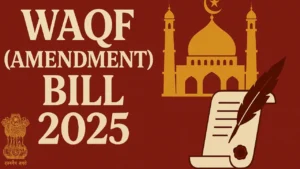
The Waqf (Amendment) Act 2025 (passed in April 2025) had introduced sweeping changes in the management of Waqf properties, leading to widespread constitutional challenges.
Background – Challenge to the Act –
- Petitioners — Political leaders and organisations (including AIMIM MP Asaduddin Owaisi, TMC MP Mahua Moitra, RJD MP Manoj Kumar Jha, YSR Congress, and CPI). Around 65 petitions consolidated before the Supreme
- Grounds of challenge — Violation of Article 26 (right to manage religious affairs) of the Constitution and alleged infringement of the autonomy of the Muslim community in managing Waqf properties.
• Test of constitutionality —
- Generally, no law is stayed in its entirety because the Constitution’s Article 13(2) clearly says that only the provisions that contravene fundamental rights are void.
- The bench did exactly this in the interim order and stayed a few provisions of the
Supreme Court’s Interim Relief –
• Powers of District Collectors (Section 3C) —
- Provision stayed: District Collectors’ powers to declare a Waqf property as government property during inquiry.
- Reason:Prima facie arbitrary and contrary to the principle of separation of
• Interim safeguard:
- Property to retain Waqf status during
- Waqfs not to be
- No third-party rights to be created until final decision by a Waqf
• Inclusion of non-muslims in Waqf Boards —
- The new law allowed for a non-Muslim majority in Waqf boards and the Central Waqf
• Direction issued by SC to avoid ambiguity:
- Central Waqf Council, which has 22 members, shall not consist of more than four non- Muslim members.
- State Waqf Boards, with 11 members, shall not have more than three non-Muslim
- Rationale:To prevent violation of a community’s right to religious self-management.
• Five-year rule for practising Islam —
- Provision stayed: Requirement that only a Muslim practising Islam for at least 5 years could create a Waqf.
- Condition: Stay will continue until the government frames rules specifying mechanisms to determine religious practice.
Provisions not Stayed –
• Abolition of “Waqf by Use” —
- Background: This long-standing principle meant that land used for Muslim religious or charitable purposes for a long time could be deemed to be a Waqf even if it was not formally registered as such.
- Petitioners’ argument: They had strongly opposed the omission of the concept of “Waqf by use”.
- Government stance: The government had argued that this concept was being misused to
encroach upon government lands.
- Court’s view: The court did not find a prima facie case to stay the prospective abolition of this concept.
• Applicability of the Limitation Act —
- Earlier law (1995 Act): It had specifically excluded the application of the Limitation Act, which allowed Waqfs to act against encroachments on their properties without any time
- Amendment (2025 Act): The 2025 law removed this exemption, meaning legal claims against encroachment must be made within a specific period.
- Court’sobservation: This corrects earlier discrimination; provision not
Significance of the Interim Order –
- Balances community rights with government’s regulatory
- Prevents arbitrary dispossession of Waqf properties while ensuring disputes are adjudicated by Waqf Tribunals.
- Provides clarity on non-Muslim participation limits in Waqf
Broader Concerns –
• Property rights vs. religious law —
- The court upheld the exclusion of non-Muslims from creating Waqf, despite historical
- For example, in Motishah v. Abdul Gaffar (1956), the Nagpur HC upheld the right of non- Muslims to create a waqf.
- Critics argue it infringes property rights and limits philanthropy for secular causes
(schools, hospitals, roads).
- Secular state dilemma — Allowing officials to judge “good Muslims” vs “bad Muslims” challenges India’s secular and liberal democratic framework.
- Comparative lens — Hindu, Sikh, Buddhist and Jain endowment laws have their own limitations, raising parity questions.
- Missed opportunity — The Act could have been a step toward Uniform Civil Code (UCC) covering all religious endowments.
Conclusion –
- The matter remains sub judice, with the stay operative until final adjudication of constitutional
- The case will test the balance between religious freedoms under Article 26, secular state oversight, and property rights.
- A final ruling will have significant implications for the governance of Waqf properties, minority rights, and the principle of separation of powers in India’s constitutional
Doctrine of Escheat
The Supreme Court recently held that a State Government cannot invoke the doctrine of escheat under Section 29 of the Hindu Succession Act once a Hindu male has executed a Will, which has been declared to be valid and has been granted probate by a Court.
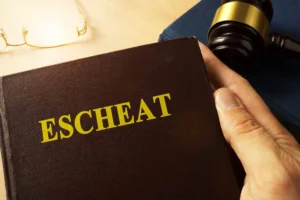
About Doctrine of Escheat –
• It is a significant legal concept that ensures no property is left without ownership, reverting it to the state if the original owner dies without legal heirs or fails to make a will.
- This legal process addresses the handling of unclaimed assets, protecting societal interests and maintaining order within the legal
- The doctrine addresses two primary situations —
• when a person dies intestate (without a will) and without heirs, and
• when property remains unclaimed or abandoned for a specific period.
- The underlying principle of escheat is that property must always have an identifiable owner,
and in the absence of heirs, the government assumes ownership.
- In modern legal systems, escheat serves as a way to maintain orderly succession and
prevent assets from being wasted or misused.
- Historical Origins of Escheat —
- Escheat originates from the Old French word “eschete,” meaning “to fall to”.
- The concept of escheat is rooted in the feudal system of medieval Europe, where land was held by tenants under a lord.
- If the tenant died without an heir or was convicted of certain crimes like treason, the
land would escheat, or revert, to the lord.
- This system allowed for continuous control of land, ensuring that property remained within the hierarchy of the feudal
• Over time, this evolved to include the monarch or the state as the ultimate recipient of property without heirs.
- Escheat in Modern Legal Systems —
- In modern legal systems, escheat ensures that unclaimed or ownerless property does not remain in limbo but is transferred to the
• The state assumes ownership of such property, either permanently or temporarily, until rightful claimants can be found.
- Escheat laws vary across jurisdictions, with some countries having well-defined processes for handling unclaimed assets.
• In India, escheat is regulated primarily through Section 29 of the Hindu Succession Act, 1956, and Article 296 of the Constitution.
- These provisions outline the circumstances under which property escheats to the state, safeguarding against unclaimed or abandoned property.
- However, the Supreme Court made it clear that the doctrine of escheat under Section 29 of the Hindu Succession Act, 1956, is a remedy of last resort; it comes into play only when a person dies intestate and without any legal heirs.
- Where a valid will is executed and duly probated, the property must devolve strictly in line with the testator’s intent, leaving no room for the State to assert rights over the
Polypropylene
Recently, the Prime Minister of India laid the foundation stone for a polypropylene plant at Numaligarh Refinery Limited (NRL) at Golaghat in Assam.
About Polypropylene –
- It is a thermoplastic polymer produced by the addition polymerisation of
- It is a synthetic resin built up by the polymerisation of
- It is one of the important family of polyolefin
- Polypropylene is moulded or extruded into many plastic products in which toughness, flexibility, light weight, and heat resistance are required.
• Properties of Polypropylene —
- It is highly resistant to chemical corrosion, making it an excellent choice for packaging of cleaning products and bleaches.
- It is a commodity plastic with low density and high heat
- Flammability: PP is a highly flammable
- Density: PP is one of the lightest polymers among all commodity
• Application of Polypropylene —
- It is widely used in polymer materials in the plastic manufacturing industry to produce various end products, especially plastic packaging.
- Polypropylene has high insulation properties too, making it safe to use for plastic casing in electrical goods and cables.
- It offers impressive chemical and biological-resistant properties and makes polypropylene an obvious choice for the medical industry.
Centre for Cellular and Molecular Biology (CCMB)
Scientists at CSIR-Centre for Cellular and Molecular Biology (CCMB) recently discovered how white blood cells can adapt their internal skeletons to combat pathogens.
About Centre for Cellular and Molecular Biology (CCMB) –
- It is India’s premier research organisation in frontier areas of modern biology.
- The objectives of the Centre are to conduct high-quality basic research and training in frontier areas of modern biology, and promote centralised national facilities for new and modern techniques in the interdisciplinary areas of biology.
- Located in Hyderabad, Telangana, CCMB is a constituent laboratory of the Council of Scientific and Industrial Research (CSIR), a renowned national organisation under the Ministry of Science and Technology, Government of India.
- Established in 1977, CCMB has emerged as a global leader in cellular and molecular research and is known for its contributions to understanding the molecular mechanisms that govern biological systems.
• CCMB’s work spans various disciplines of biology, including genetics, biotechnology, bioinformatics, immunology, and molecular medicine.
- The institution is well-regarded for its cutting-edge research in molecular biology, genomics, proteomics, and cellular mechanisms.
- The centre’s research is both fundamental and translational, focusing on problems that have wide-ranging implications for medicine, disease management, agricultural improvement, and environmental sustainability.
- CCMB has state-of-the-art facilities for research, including a high-throughput genomics facility and a bioinformatics centre.
- The institute also offers training programs and workshops for students and researchers and collaborates with national and international
• CCMB is a designated “Centre of Excellence” by the Global Molecular and Cell Biology Network, UNESCO.
Exercise Pacific Reach 2025
Indian Navy’s latest indigenously designed and constructed Diving Support Vessel (DSV) INS Nistar is participating in Exercise Pacific Reach 2025 in Singapore.

About Exercise Pacific Reach 2025 –
- It is a multinational conducted in
- It is a biennial exercise which will witness participation of more than 40
- The exercise is mainly conducted in two phases, including the harbour and sea
- Focus of the Exercise: The harbour phase will involve in-depth discussions on submarine rescue systems, Subject Matter Expert Exchanges (SMEE), a medical symposium and cross- deck visits between the participating nations.
- The Sea phase of the exercise would witness INS Nistar and Submarine Rescue Unit (E) engaging in multiple intervention and rescue operations with participating assets in the South China Sea.
Key Facts about INS Nistar –
• It was commissioned on 18th July 2025.
- It was developed by HSL, Visakhapatnam, under the Ministry of Defence’s ‘Aatmanirbhar Bharat’ initiative.
- The ship with its Side Scan Sonar, Work & observation class ROVs and expansive deep sea diving systems will be carrying out the role of mothership (MoSHIP) for Deep Submergence Rescue Vehicle (DSRV).
• Diving and Rescue Capabilities —
- Integrated Saturation Diving System (ISDS): Enables diver deployment at depths up to 300 meters, supporting underwater repairs, salvage, and rescue operations.
- Remotely Operated Vehicles (ROVs): These can be deployed for underwater surveillance and recovery missions in deep waters.
- Side Scan Sonar and Integrated Platform Management System (IPMS): Aid in locating submerged vessels or wreckage and managing onboard systems, respectively.
- Submarine Rescue System: Especially crucial for submarine emergencies, allowing the timely and safe recovery of personnel from disabled submarines.
Red Fort
A ‘black crust’ is forming on the walls of the Red Fort due to high levels of air pollution, a recent study has found.
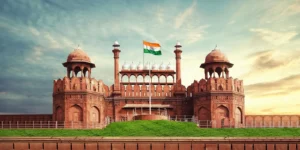
About Red Fort –
- The Red Fort, or Lal Qila, is a Mughal fort located in Delhi,
- Formerly known as Quila-e-Mubarak, or the Blessed Fort, the Red Fort lies along the banks of the river Yamuna, whose waters fed the moats surrounding the fort.
• It was built as the palace fort of Shahjahanabad – the new capital of the fifth Mughal Emperor of India, Shah Jahan.
- Shah Jahan constructed it in It was designed by architects Ustad Ahmad Lahauri and Ustad Hamid.
- Named for its massive enclosing walls of red sandstone, it is adjacent to an older fort, the
Salimgarh, built by Islam Shah Suri in 1546, with which it forms the Red Fort Complex.
- The fort complex served as the residence of Mughal Emperors for nearly 200 years, until
- The fort was designated a UNESCO World Heritage site in
- From the fort each year on Independence Day (August 15), the Indian prime minister participates in a flag-raising ceremony and delivers a televised address to the country.
• Architecture —
- The Red Fort’s massive red sandstone walls, which stand 75 feet (23 metres) high, enclose a complex of palaces and entertainment halls, projecting balconies, baths and indoor canals, and geometrical gardens, as well as an ornate mosque.
- The planning of the palace is based on Islamic prototypes, but each pavilion reveals architectural elements typical of Mughal buildings, reflecting a fusion of Persian, Timurid, and Hindu traditions.
- The fort is octagonal, with the north-south axis longer than the east-west
- Among the most famous structures of the complex are the Hall of Public Audience (Diwan-i-ʿAm), which has 60 red sandstone pillars supporting a flat roof, and the Hall of Private Audience (Diwan-i-Khas), which is smaller and has a pavilion of white marble.
- The marble, floral decorations, and double domes in the fort’s buildings exemplify later Mughal architecture.
- It has 2 principal gates–Lahore Drawaza and Delhi Darwaza along its western and southern sides, respectively.
Lake Natron
Recently, Tanzania’s government halted a planned large-scale soda ash mining project at Lake Natron.
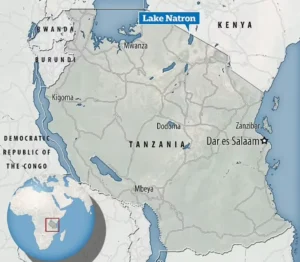
About Lake Natron –
- Location — It is a salt lake located on the border between Tanzania and Kenya.
- It is part of the eastern branch of the Great Rift
- It has a unique composition of warm waters and salt, caustic soda, and magnesite deposits that provide ideal conditions for flamingos to
- It was designated as a Ramsar Site of International Importance in
- Primarily, the lake is fed by the Ewaso Ng’iro River, which originates from the central region of
- One of the most striking features of this Lake is its striking red coloration. The primary reason for its hue lies in its extreme alkalinity.
- It is the only reliable breeding ground for Lesser Flamingos in Africa, supporting up to 75 per cent of the world’s population.
- Lesser flamingos feed on Lake Natron with Shompole volcano (situated on the border of Kenya and Tanzania) in the distance at the northern end of the
- Threats — Several factors, including agriculture, pollution, and climate change, are threatening the beauty of this unique ecosystem.
Eustoma
Recently, the National Botanical Research Institute (NBRI), a research arm of the Council of Scientific and Industrial Research (CSIR), has achieved a breakthrough by cultivating Eustoma flower in Odisha.
About Eustoma –
- It is commonly known as Lisianthus or Prairie Gentian or Texas
- It is a perennial herbaceous ornamental species that is used as cut flower and is among the top ten popular cut flowers globally.
- The plant originates from the grasslands of North
- Features — It is admired for its wide colour range, long vase life and suitability for cut flowers and potted plants.
- Because of its enormous rose‐like blossoms, long stems and extended vase life, its sales have increased dramatically in recent years, earning it the title of ‘next rose’.
- Habitat — It typically grows in grasslands and disturbed areas, thriving in warm
- Soil Required — Well drain, moisture-retentive soil and garden compost or well-rotted
- It is native to Mexico, southern USA, Caribbean, and northern South
- It has a great cosmopolitan demand mainly for its large and attractive flowers, long and hard stem, and wide range of colours.
Red Coral Kukri Snake
Recently, a rare Red Coral Kukri Snake species, last reported in 1936, was recently found trapped in a net in a village field near Pilibhit Tiger Reserve.
About Red Coral Kukri Snake –
- It is identified as Oligodon
- It is one of the rarest non venomous snake
- This nocturnal and fossorial snake is specialized with curved teeth like kukri (Nepalian Knife). Hence, they are called “Kukri”.
- Appearance — Its whole body including the head is uniform bright coral-red without any patterns and the underside is yellowish or pinkish hence it is one of the most distinct snakes of its range.
- Its head is short, not broader than the neck and bears an obtusely pointed
- Distribution — It is widely distributed in lowlands (below 1500ft) of Himalayan foothills from Uttrakhand, Nepal, northern parts of Uttar Pradesh, Bihar and West Bengal to Sikkim and western Assam.
• Conservation Status —
- IUCN: Least Concern (LC)
- Wild Life Protection Act: Schedule –IV
Key Facts about Pilibhit Tiger Reserve –
- It is located in the state of Uttar
- It lies along the India-Nepal border in the foothills of the Himalayas and is part of the Terai Arc
- Rivers: The river Gomti originates from the PTR, which is also the catchment of several others like Sharda, Chuka, and Mala Khannot.
- Habitat: The habitat is characterised by dense sal forests and tall alluvial grasslands, savannahs, and impenetrable swamps, maintained by periodic flooding from rivers.
- The Sharda Sagar Dam, extending up to a length of 22 km, is on the boundary of the
- It has a dry and hot climate, which brings a combination of dry teak forest and Vindhya Mountain soils.
Daily Current Affairs 17th September 2025 MCQs
1. Consider the following statements regarding the Carlsberg Ridge –
- It is a divergent plate boundary located in the Indian
- It marks the boundary between the Somali Plate and the Indian
- It extends northwest from a triple junction to the Gulf of
- It is the most prominent mid-ocean ridge segment of the eastern Indian
Which of the statements given above are correct?
- 1 and 2 only
- 1, 2 and 3 only
- 2, 3 and 4 only
- All of the above
Answer – B
Explanation – It is a mid-oceanic ridge (a divergent plate boundary) located in the Indian Ocean. The ridge extends from the triple junction of the African, Indian, and Australian tectonic plates (where it connects to the Mid-Indian Ridge) northwest to the Gulf of Aden. The ridge separates the Arabian Sea to the northeast from the Somali Basin to the southwest. It marks the boundary between the Somali Plate and the Indian Plate. The mean depth of the Carlsberg Ridge is between some 6,000 and 12,000 feet (1,800 and 3,600 meters) below the sea surface, and it rises to a mean elevation of about 7,000 feet (2,100 meters) above the seafloor. The ridge turns westward around the island of Socotra and eventually connects with the East African Rift System by way of the Gulf of Aden. It is the most prominent mid-ocean ridge segment of the western Indian Ocean, which contains a number of earthquake epicenters.
2. Which of the following statement(s) is/are correct about the ‘International Seabed Authority’?
- It was established in the year 1974 by the UNCLOS as an autonomous intergovernmental body having observer status at the UN.
- Its headquarter is located in
- India is the first country to have received the status of a pioneer investor in 1987 to explore Central Indian Ocean Basin for exploration and utilisation of nodules.
Select the correct codes from below –
- 1 and 2 only
- 2 and 3 only
- 1 and 3 only
- None of the above
Answer – C
Explanation – It was established in 1994 by UNCLOS (UN Convention on Laws of Sea) with its headquarter at Kingston, Jamaica. It is an autonomous intergovernmental body having observer status at the UN. Its task is to organise, regulate and control all mineral-related activities in the international Seabed Area beyond the limits of national jurisdiction. There are 167 members and the European Union of the ISA. India is the first country to have received the status of a pioneer investor in 1987 and was allocated an exclusive area in Central Indian Ocean Basin (CIOB) by UN for exploration and utilisation of nodules.
3. Which of the following statement(s) is/are incorrect?
- The statutory bail accrues when the police fails to complete investigation within a specified period in respect of a person in police custody alone.
- A regular bail is generally granted to a person who is under judicial custody
- Anticipatory bail cannot be provided to an accused who has been charged for a non-bailable
Select the correct codes from below –
- 1 and 2 only
- 2 and 3 only
- 1 and 3 only
- All of the above
Answer – D
Explanation – All statements are incorrect. There are commonly four types of bail in India –
- Default Bail –
- This is a right to bail that accrues when the police fail to complete investigation within a specified period in respect of a person in judicial/ police It is also known as statutory bail.
- At the end of this specified period, if the investigation is not complete, the court shall release
the person “if he is prepared to and does furnish bail”.
- This is enshrined in Section 167(2) of the Code of Criminal Procedure (CrPC).
- Regular Bail -A regular bail is generally granted to a person who has been arrested or is in police custody. A bail application can be filed for the regular bail under section 437 and 439 of CrPC.
- Interim Bail – This type of bail is granted for a short period of time by the Court till the application seeking Anticipatory Bail or Regular Bail is pending before a Court.
- Anticipatory Bail – Anticipatory bail is granted under section 438 of CrPC either by session court or High Court. An application for the grant of anticipatory bail can be filed by the person who discerns that he may be arrested by the police for a non-bailable offence.
4. Consider the following statements regarding the Doctrine of Escheat in India –
- It is the primary mechanism for the state to assume ownership of property when a person dies without a will and without any legal
- It applies to all properties of a deceased person, irrespective of the existence of a valid
- The constitutional basis for the doctrine is provided under Article 296 of the Indian
Which of the statements given above is/are correct?
- 1 and 2 only
- 2 and 3 only
- 1 and 3 only
- All of the above
Answer – C
Explanation – It is a significant legal concept that ensures no property is left without ownership, reverting it to the state if the original owner dies without legal heirs or fails to make a will. This legal process addresses the handling of unclaimed assets, protecting societal interests and maintaining order within the legal framework. The doctrine addresses two primary situations — when a person dies intestate (without a will) and without heirs, and when property remains unclaimed or abandoned for a specific period. The underlying principle of escheat is that property must always have an identifiable owner, and in the absence of heirs, the government assumes ownership. In modern legal systems, escheat serves as a way to maintain orderly succession and prevent assets from being wasted or misused. In modern legal systems, escheat ensures that unclaimed or ownerless property does not remain in limbo but is transferred to the state. The state assumes ownership of such property, either permanently or temporarily, until rightful claimants can be found. Escheat laws vary across jurisdictions, with some countries having well- defined processes for handling unclaimed assets. In India, escheat is regulated primarily through Section 29 of the Hindu Succession Act, 1956, and Article 296 of the Constitution. These provisions outline the circumstances under which property escheats to the state, safeguarding against unclaimed or abandoned property. However, the Supreme Court made it clear that the doctrine of escheat under Section 29 of the Hindu Succession Act, 1956, is a remedy of last
resort; it comes into play only when a person dies intestate and without any legal heirs. Where a valid will is executed and duly probated, the property must devolve strictly in line with the testator’s intent, leaving no room for the State to assert rights over the estate.
5. Consider the following statements regarding Polypropylene –
- It is produced by the addition polymerisation of
- It is highly resistant to chemical corrosion and has high heat
- It is a naturally occurring polymer with high
Which of the statements given above is/are correct?
- 1 and 2 only
- 2 and 3 only
- 1 and 3 only
- All of the above
Answer – A
Explanation – It is a thermoplastic polymer produced by the addition polymerisation of propylene. It is a synthetic resin built up by the polymerisation of propylene. It is one of the important family of polyolefin resins. Polypropylene is moulded or extruded into many plastic products in which toughness, flexibility, light weight, and heat resistance are required. Properties of Polypropylene
— It is highly resistant to chemical corrosion, making it an excellent choice for packaging of cleaning products and bleaches. It is a commodity plastic with low density and high heat resistance. Flammability: PP is a highly flammable material. Density: PP is one of the lightest polymers among all commodity plastics. Application of Polypropylene — It is widely used in polymer materials in the plastic manufacturing industry to produce various end products, especially plastic packaging. Polypropylene has high insulation properties too, making it safe to use for plastic casing in electrical goods and cables. It offers impressive chemical and biological- resistant properties and makes polypropylene an obvious choice for the medical industry.
Source – The Hindu
Also read Daily Current Affairs – 18 September 2025 | Top News







